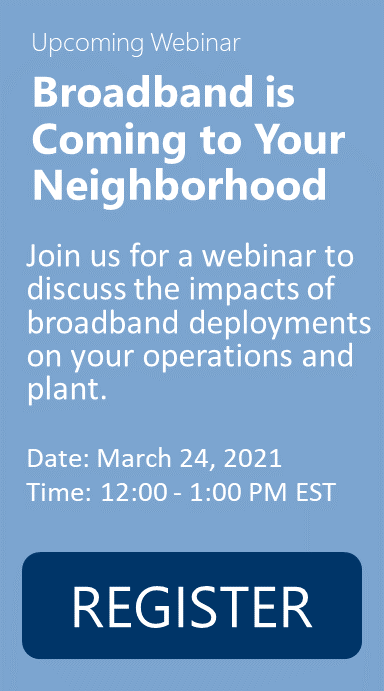Broadband is Coming to Your Neighborhood Now
 The Federal Communications Commission (FCC) and other federal and state agencies have awarded billions of dollars to utilities and telecommunications providers to deliver broadband to the underserved areas of the United States. In addition to the FCC awards, legislation is being proposed in congress to provide billions of dollars to improve and expand existing broadband networks. This flood of funding, the wireless industries fifth generation (5G) technology upgrade, and new regulations intended to accelerate the deployment of wireline and wireless facilities quicker will impact pole owners in many ways.
The Federal Communications Commission (FCC) and other federal and state agencies have awarded billions of dollars to utilities and telecommunications providers to deliver broadband to the underserved areas of the United States. In addition to the FCC awards, legislation is being proposed in congress to provide billions of dollars to improve and expand existing broadband networks. This flood of funding, the wireless industries fifth generation (5G) technology upgrade, and new regulations intended to accelerate the deployment of wireline and wireless facilities quicker will impact pole owners in many ways.
How will these broadband activities impact pole owners and those seeking to build broadband networks?
- For utilities or broadband providers awarded funding to construct broadband networks, there may be challenges in providing qualified resources to survey, engineer, and inspect their new networks so their broadband networks can be deployed to meet the timelines and benchmarks required with the acceptance of funding awards.
- For pole owners impacted by telecommunications company broadband construction, there may be challenges in managing the administration of pole attachment applications in a timely and efficient manner to comply with the faster timeframes required by regulations.
Fortunately, proven practices and improved technology can minimize the impact and help utilities and pole owners stay in compliance with regulations and improve safety, reliability, and customer satisfaction.
The Osmose Solution
%20(1).webp?width=600&height=400&name=Fiber%20Reels%20(1)%20(1).webp) An organized, efficient approach to pole attachment management will ensure that pole owners meet the increased activity expected with the new pole attachment rules. Osmose implements a pole attachment management solution using skilled personnel and proven technology.
An organized, efficient approach to pole attachment management will ensure that pole owners meet the increased activity expected with the new pole attachment rules. Osmose implements a pole attachment management solution using skilled personnel and proven technology.
Step 1: Review Existing Agreements- The approach begins with a review of existing pole attachment agreements to determine compliance with the new regulations, responsibility for payment, and cost-recovery mechanisms for performing an audit.
Step 2: Establish Accurate Baseline of Current Attachments (via Cost-Recoverable Audit)- If it's been over five years since your last audit, an audit of attachments should be performed by qualified inspectors who understand both electric telecommunications infrastructure and NESC requirements. Osmose skilled technicians are equipped with the best field tools available to collect and analyze attachments, pole condition, and to assess clearances (measured), and capture images to support next steps. Osmose uses highly accurate Digital Measuring Technology to collect measurements and performs detailed clearance and load assessments using Osmose industry-leading O-Calc® Pro software. The results can then be posted to the Osmose 360 Joint Use portal, a robust, map-based, online portal that allows participants in the audit to review and interact with the data relating to their attachments. The Osmose sophisticated data collection process delivers a faster, more accurate audit which allows the utility to assess the state of their pole plant and manage their risk exposure effectively.
Step 3: Addressing Issues Resulting from the Audit through Remediation- One item discovered in many attachment audits are replaced poles remaining in the right-of-way after the pole owner utility has transferred to a new pole. These "double wood" or "buddy poles" are a sore spot with regulators and represent an unnecessary safety risk for the pole owner utility that should be addressed urgently. NESC/GO95 clearance violations, caused by third party attachments are another issue. Remediation of these issues involves communication with third party stakeholders (ticket management), as well as resources to coordinate, design, schedule and review that the appropriate fixes have been performed. Osmose national corps of "boots on the ground" technicians and scores of engineers and project coordinators can expedite resolution of this unsightly hazard by performing make-ready engineering, pole loading analysis, and coordinating the movement of attachments to ensure transfers to new poles are performed expeditiously and safely.
Step 4: Keeping Your Pole Plant Data Pristine (Turnkey Pole Application Management)- Following the above steps, new pole attachment applications must be managed effectively to ensure the safe and timely provisioning of attachment requests and compliance with regulations. Budgeting for and staffing to deal with the peaks and valleys of managing incoming applications in a timely manner is one of the biggest challenges and risks to your poles. Osmose can turnkey manage a program focused on ensuring that joint use administration is performed efficiently so the utility can focus on its core business of delivering safe, reliable, and affordable service to its customers. This can include our Osmose 360 Joint Use portal to support the receipt and tracking of all new requests and the experienced resources to perform any required application review, surveys, pole loading, make-ready design, estimating, work order writing, and post-construction audits.
For more information on how Osmose can help protect and maximize the use of your pole infrastructure and underground substructure please go to www.osmose.com, call 770.631.6995, or email poleinfo@osmose.com.
.png?width=243&name=Osmose-logo-(white).png)